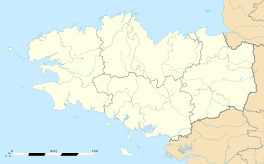St Malo
|
Saint-Malo Saent-Malô |
|||
|---|---|---|---|

Walled city
|
|||
|
|||
| Coordinates: 48°38′53″N 2°00′27″W / 48.6481°N 2.0075°WCoordinates: 48°38′53″N 2°00′27″W / 48.6481°N 2.0075°W | |||
| Country | France | ||
| Region | Brittany | ||
| Department | Ille-et-Vilaine | ||
| Arrondissement | Saint-Malo | ||
| Canton | Saint-Malo-Nord and Saint-Malo-Sud | ||
| Intercommunality | Saint-Malo | ||
| Government | |||
| • Mayor (2014-2020) | |||
| Area1 | 36.58 km2 (14.12 sq mi) | ||
| Population (2012)2 | 44,620 | ||
| • Density | 1,200/km2 (3,200/sq mi) | ||
| Time zone | CET (UTC+1) | ||
| • Summer (DST) | CEST (UTC+2) | ||
| INSEE/Postal code | 35288 / 35400 | ||
| Elevation | 0–51 m (0–167 ft) (avg. 8 m or 26 ft) |
||
|
1 French Land Register data, which excludes lakes, ponds, glaciers > 1 km² (0.386 sq mi or 247 acres) and river estuaries. 2Population without double counting: residents of multiple communes (e.g., students and military personnel) only counted once. |
|||
1 French Land Register data, which excludes lakes, ponds, glaciers > 1 km² (0.386 sq mi or 247 acres) and river estuaries.
Saint-Malo (French pronunciation: [sɛ̃.ma.lo]; Gallo : Saent-Malô; Breton: Sant-Maloù) is a walled port city in Brittany in northwestern France on the English Channel. It is a sub-prefecture of the Ille-et-Vilaine.
Traditionally with an independent streak, Saint-Malo was in the past notorious for privateering (the "cité corsaire"). Today the city is a major tourist destination, with many ancient, attractive buildings.
The population can increase to up to 200,000 in the summer tourist season. With the suburbs included, the population is approximately 153,000 (2011).
The population of the commune more than doubled in 1968 with the merging of three communes: Saint-Malo, Saint-Servan (population 14,963 in 1962) and Paramé (population 8811 in 1962).
Inhabitants of Saint-Malo are called Malouins in French. From this came the name of the Malvinas – the Falkland Islands named Îles Malouines by French explorer Louis-Antoine de Bougainville in 1764.
Founded by Gauls in the 1st century B.C. The ancient town on the site of Saint-Malo was known as the Roman Reginca or Aletum. By the late 4th century AD the Saint-Servan district was the site of a major Saxon Shore promontory fort that protected the Rance river estuary from seaborne raiders from beyond the frontiers. According to the Notitia Dignitatum the fort was garrisoned by the militum Martensium under a dux (commander) of the Tractus Armoricanus and Nervicanus section of the litus Saxonicum. During the decline of the Western Roman Empire Armorica (modern day Brittany) rebelled from Roman rule under the Bagaudae and in the 5th and 6th centuries received many Celtic Britons fleeing instability across the Channel. The modern Saint-Malo traces its origins to a monastic settlement founded by Saint Aaron and Saint Brendan early in the sixth century. Its name is derived from a man said to have been a follower of Brendan the Navigator, Saint Malo or Maclou, an immigrant from what is now Wales.
...
Wikipedia




